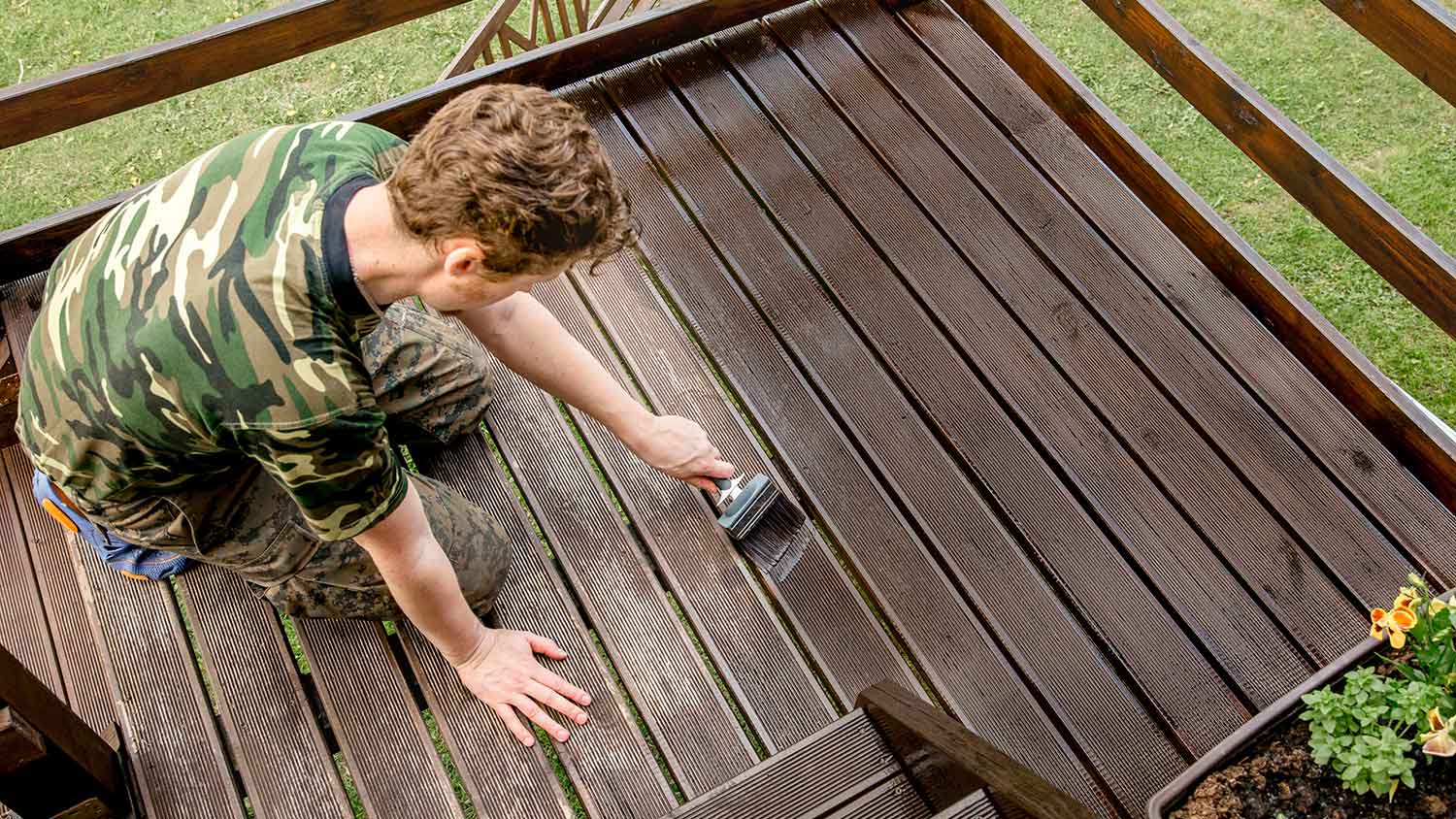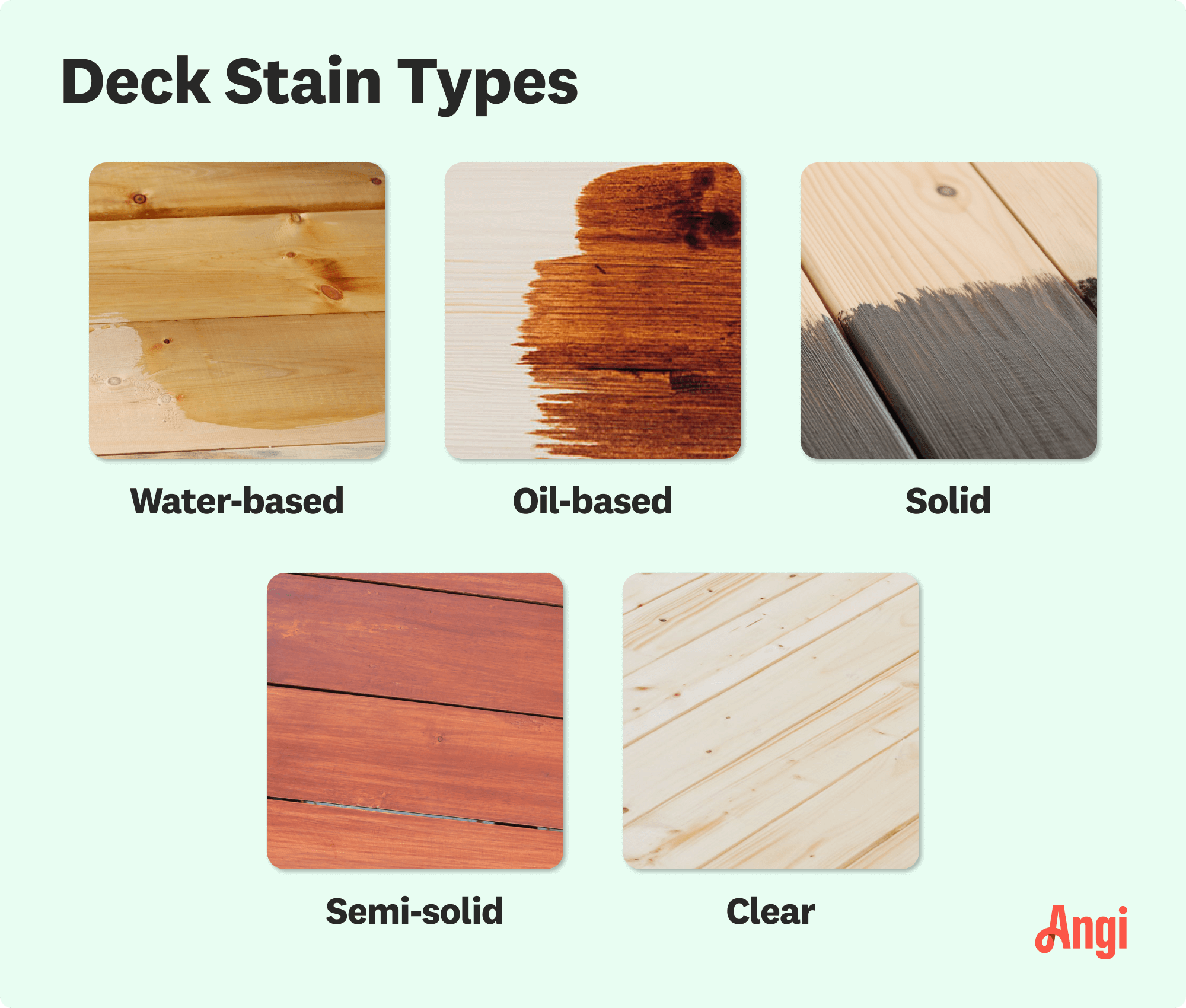
The cost to paint vinyl siding depends on the type of paint, square footage, labor, and more. Check out this guide to help you budget for painting vinyl siding.
Avoid the pain and get a great stain


The best time to stain a deck is in late spring or early summer.
Don’t stain a deck in rainy, snowy, or especially humid or hot conditions.
Moisture of any kind inhibits wood's ability to absorb a stain.
Staining a deck costs $2 to $4 per square foot, on average.
When your deck starts to lose its luster, you may want to give it a refresh by staining it. Before you dive in, it’s a good idea to find out exactly when is the best time to stain a deck. Everything from the weather to the time of day can impact how it turns out. Otherwise, all your hard work could leave you with a final result that’s less than impressive.
The best time to stain a deck will depend on your local climate. Use this guide to find your perfect moment to tackle this project.

You should aim to stain a deck when the weather is dry and warm but not hot, and avoid wet and humid conditions at all costs. Late spring and early summer are most often recommended for exterior home projects, including deck staining, but the specifics of each season can vary greatly from one state to another.
Instead, rely on your knowledge about your local climate to determine the best moment for a project like this. If you know that the rain is unceasing throughout all of spring, but that summers are relatively cool and not too sunny, opt for the latter. Alternatively, if your summers start off hot and humid, consider waiting for early fall when the weather is slightly cooler and drier.

Even though weather plays the biggest part in the correct timing for deck staining, it’s not the only factor to consider. Here’s everything you should take into account before setting a date for this project.
Before you can stain a deck, you have to make sure it’s in the right condition. If it’s damaged or decaying, even only a little bit, take care to make repairs like replacing broken parts or sanding the deck in advance. If you’re planning on power washing, you’ll also need to leave ample time for it to dry out fully afterward.
Even the slightest amount of moisture will repel staining products and inhibit their proper absorption into the wood, so avoid working in rainy or snowy conditions. While it’s not always easy to plan for ideal weather, pick a time of the year when you know you can count on it being relatively dry to avoid issues. That could be in late spring in the Northeast or early fall in the Southwest, for instance.
Liquid doesn’t have to fall from the sky to interfere with your deck-staining mission. In fact, high humidity can be just as if not more problematic, as the deck wood can absorb moisture straight from the air. High temperatures and direct sunlight also pose problems, like causing the stain to dry before being completely applied and appearing streaky and uneven as a result.
Late spring and early fall are the typical seasons designated for a project like this, so it may be harder to find a pro who will accept the job outside of them. On the flip side, if you are able to find someone, you may end up paying less while they’re not as booked and busy.
Before applying the stain, it’s a good idea to test for a mill glaze. This is when the wood is unable to absorb products or treatments because of the high pressure and heat used in processing. Simply pour a small amount of water onto one spot on your deck to see if this is an issue you’re dealing with. If the water does not absorb, you’ll need to remove the glaze through methods like power or pressure washing or by using a percarbonate cleaner.
Extended exposure to direct sunlight will mess up your stain before it has a chance to dry. If there’s no shade coverage or partly cloudy days on the horizon, plan to do the work before noon and after 4 p.m. to dodge the rays.
Finding the best time to stain a deck is a bit like Goldilocks hunting for the perfect bowl of porridge: You want it to be just right. By contrast, the worst moments are all the ones in between. Working in conditions that are too hot or cold or too wet from rain or humidity will never end well.
The average cost to stain is about $850, but it often ranges from $550 to $1,250. What you pay will largely depend on your deck’s size, as staining costs are about $2 to $4 per square foot. Labor fees make up most of that total cost, so you can save up to 75% by DIYing it instead.
Despite the savings potential, there are a couple of instances where you’re better off leaving this job to a trained hand. If the working conditions aren’t ideal—like inopportune weather—or there are a lot of other fixes to be made, make your life easier by hiring a deck painting pro near you instead.
From average costs to expert advice, get all the answers you need to get your job done.

The cost to paint vinyl siding depends on the type of paint, square footage, labor, and more. Check out this guide to help you budget for painting vinyl siding.

The cost to paint a house's exterior depends on its size, siding type, and height. The finish and the home's exterior condition also play a role.

The cost to paint a deck depends on its size, design, and whether you DIY. Read this guide to help set the budget for your deck painting project.

Stain protects your wood and enhances its natural beauty. Learn how long it takes for stains to dry based on your project, the type of stain, and the weather.

Breathe new life into your deck by sanding it before adding stain. Follow this guide to learn how to sand a deck and choose the right grit sandpaper.

How many coats of paint you need for your home’s exterior or interior depends on factors like the original paint color and surface texture. Our guide breaks it down.